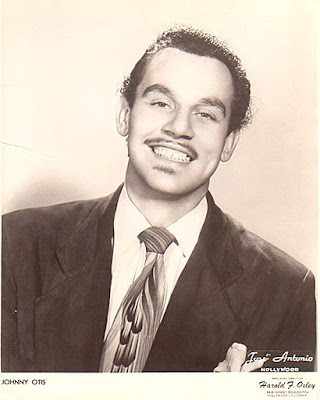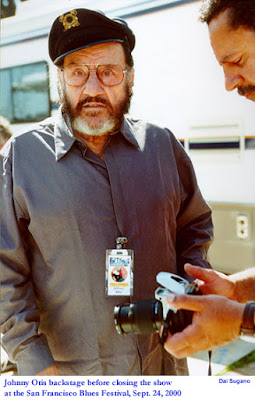Johnny Otis (born Ioannis Alexandres Veliotes; December 28, 1921 – January 17, 2012) was an American singer, musician, composer, arranger, bandleader, talent scout, disc jockey, record producer, television show host, artist, author, journalist, minister, and impresario. A seminal influence on American R&B and rock and roll, Otis discovered artists such as Little Esther, Big Mama ![]() Thornton, Jackie Wilson, Little Willie John and Hank Ballard and Etta James. Known as the original "King of Rock & Roll", he is commonly referred to as the "Godfather of Rhythm and Blues".
Thornton, Jackie Wilson, Little Willie John and Hank Ballard and Etta James. Known as the original "King of Rock & Roll", he is commonly referred to as the "Godfather of Rhythm and Blues".
 Thornton, Jackie Wilson, Little Willie John and Hank Ballard and Etta James. Known as the original "King of Rock & Roll", he is commonly referred to as the "Godfather of Rhythm and Blues".
Thornton, Jackie Wilson, Little Willie John and Hank Ballard and Etta James. Known as the original "King of Rock & Roll", he is commonly referred to as the "Godfather of Rhythm and Blues".Otis was born in Vallejo, California, to Greek immigrants Alexander J. Veliotes, a Mare Island longshoreman and grocery store owner, and his wife, the former Irene Kiskakes, a painter. He grew up in a predominantly black neighbourhood in Berkeley, California, where his father owned a neighbourhood grocery store.
Otis began playing drums as a teenager, when he purchased a set by forging his father's signature on a credit slip. Soon after he dropped out of Berkeley High School during his junior year, Otis joined a local band with pianist friend 'Count' Otis Matthews called the ![]() West Oakland Houserockers. By 1939, they were performing at many of the local functions, primarily in and around the Oakland and Berkeley area, and became quite popular among their peers.
West Oakland Houserockers. By 1939, they were performing at many of the local functions, primarily in and around the Oakland and Berkeley area, and became quite popular among their peers.
 West Oakland Houserockers. By 1939, they were performing at many of the local functions, primarily in and around the Oakland and Berkeley area, and became quite popular among their peers.
West Oakland Houserockers. By 1939, they were performing at many of the local functions, primarily in and around the Oakland and Berkeley area, and became quite popular among their peers.Otis played in a variety of swing orchestras, including Lloyd Hunter's Serenaders, and Harlan Leonard's Rockets, until he founded his own band in 1945 and had one of the most enduring hits of the big band era, "Harlem Nocturne", an Earle Hagen composition.
His band included Wynonie Harris, Charles Brown, and Illinois Jacquet, to name a few. In 1947, he and Bardu Ali opened the Barrelhouse Club in the Watts district of Los Angeles. He reduced the size of his band and hired singers Mel Walker, Little Esther Phillips and the Robins (who later became the Coasters). He discovered the teenaged Phillips when she won one of the Barrelhouse Club's talent shows. With this band, which toured extensively throughout the United States as the California Rhythm and Blues Caravan, he had a long string of rhythm and blues hits through 1950.
Otis discovered tenor saxophonist Big Jay McNeely, who then performed on his uptempo "Barrelhouse Stomp". He began recording Little Esther and Mel Walker for the Newark, New Jersey-based Savoy label in 1949, and began releasing a stream of hit records, including "Double Crossing Blues", "Mistrustin' Blues" and "Cupid Boogie"; all three reached no. 1 on the Billboard R&B chart. In 1950, Otis was presented the R&B Artist of the Year
 trophy by Billboard. He also began featuring himself on vibraphone on many of his recordings.
trophy by Billboard. He also began featuring himself on vibraphone on many of his recordings.In 1951, Otis released "Mambo Boogie" featuring congas, maracas, claves, and mambo saxophone guajeos in a blues progression. This was to be the very first R&B mambo ever recorded.
Around the time Otis moved to the Mercury label in 1951, he discovered vocalist Etta James, who was only 13 at the time, at one
of his talent shows. He produced and co-wrote her first hit, "The Wallflower (Roll With Me, Henry)".
 |
Johnny Otis, center, with Mel Walker and Esther Phillips |
Otis produced the original recording of " Hound Dog" written by Jerry Leiber and Mike Stoller with vocal by Big Mama Thornton, and was given a writing credit on all six of the 1953 releases of the song. As an artist and repertory man for King Records he also discovered Jackie Wilson, Hank Ballard, and Little Willie John, among others. He also became an influential disk jockey in Los Angeles.
However, he continued to perform, and in April 1958, he recorded his best-known recording "Willie and the Hand Jive", which went on to be a huge hit in the summer of 1958. His most famous composition is "Every Beat of My Heart", first recorded by The Royals in the 1952 but which became a huge hit for Gladys Knight.
However, he continued to perform, and in April 1958, he recorded his best-known recording "Willie and the Hand Jive", which went on to be a huge hit in the summer of 1958. His most famous composition is "Every Beat of My Heart", first recorded by The Royals in the 1952 but which became a huge hit for Gladys Knight.
In the 1960s he entered journalism and politics, losing a campaign for a seat in the California Assembly (one reason for the loss may be that he ran under his much less well known real name). He then became chief of staff for Democratic Congressman Mervyn M. Dymally. He was also was the pastor of Landmark Community Church. In 1969 he recorded an album of sexually explicit material under the name Snatch and the Poontangs. In 1970 he played at the ![]() legendary Monterey Jazz Festival with Little Esther Phillips and Eddie "Cleanhead" Vinson.
legendary Monterey Jazz Festival with Little Esther Phillips and Eddie "Cleanhead" Vinson.
 legendary Monterey Jazz Festival with Little Esther Phillips and Eddie "Cleanhead" Vinson.
legendary Monterey Jazz Festival with Little Esther Phillips and Eddie "Cleanhead" Vinson.In the 1990s Otis bought a farm near Sebastopol, California, north of San Francisco. For a time he ran a coffee shop / grocery store / blues club, where one of the featured singers was the Georgia-born singer Jackie Payne. Around this time Otis also founded and pastored a new church, Landmark Community Gospel Church, which held weekly rehearsals in the tiny town of Forestville, California and Sunday services in Santa Rosa, California. Landmark's worship services centered on Otis' preaching and the traditional-style performances of a gospel choir and a male gospel quartet, backed ![]() by a rocking band that featured Otis' son Nicky Otis and Shuggie's son, Lucky Otis. The church closed its doors in the mid 1990s.
by a rocking band that featured Otis' son Nicky Otis and Shuggie's son, Lucky Otis. The church closed its doors in the mid 1990s.
 by a rocking band that featured Otis' son Nicky Otis and Shuggie's son, Lucky Otis. The church closed its doors in the mid 1990s.
by a rocking band that featured Otis' son Nicky Otis and Shuggie's son, Lucky Otis. The church closed its doors in the mid 1990s.Otis continued performing through the 1990s and headlined the San Francisco Blues Festival in 1990 and 2000, although because of his many other interests he went through long periods where he did not perform. He was elected to the Rock and Roll Hall of Fame in 1994.
He had a popular radio show on KPFA, called The Johnny Otis Show. This show was aired every Saturday Morning, live from the Powerhouse Brewery in Sebastopol. Listeners were invited to stop in for breakfast and enjoy the show live. Alas, the show's frequency deteriorated along with Johnny's ![]() health. When Otis moved to Los Angeles, the show stuttered, then stopped completely and now even the Powerhouse has closed its doors. The last real show was August 19, 2006 when Otis and his wife relocated back to Los Angeles.
health. When Otis moved to Los Angeles, the show stuttered, then stopped completely and now even the Powerhouse has closed its doors. The last real show was August 19, 2006 when Otis and his wife relocated back to Los Angeles.
 health. When Otis moved to Los Angeles, the show stuttered, then stopped completely and now even the Powerhouse has closed its doors. The last real show was August 19, 2006 when Otis and his wife relocated back to Los Angeles.
health. When Otis moved to Los Angeles, the show stuttered, then stopped completely and now even the Powerhouse has closed its doors. The last real show was August 19, 2006 when Otis and his wife relocated back to Los Angeles.Otis died of natural causes on January 17, 2012, in the Altadena area of Los Angeles just three days before Etta James, whom he had discovered in the early 1950s. (Info from Wikipedia)



